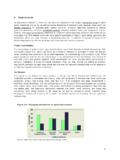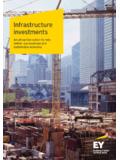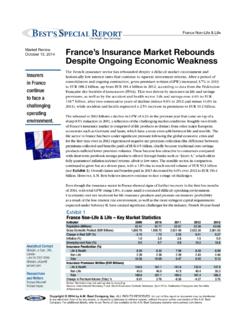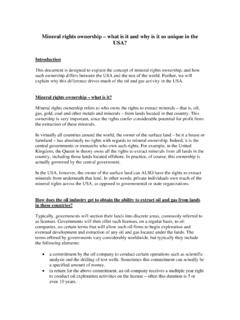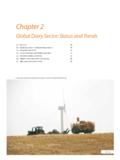Transcription of 2017 Market Forecast Report - Netherlands Maritime …
1 Newbuilding Requirements 2017 -2035 | SEA Market Forecast WG2017 Market Forecast Report32017 Market Forecast Report5 ContentsIntroduction ..7 Executive Summary ..9 Global Economic Situation ..11 Global Energy Consumption ..13 Global Seaborne Trade ..15 Newbuilding Requirements: Cargo Carriers ..17a. Containerships ..17b. General Cargo ships Forecast ..21c. Oil & Chemical Tankers ..24d. LNG & LPG Market ..25e. Bulk Carriers ..27 Newbuilding Requirements: Offshore Oil & Gas ..29a. Offshore E&P ..31b. Construction & Subsea ..32c. Offshore Wind ..33d. Offshore Supply & Service ..34 Newbuilding Requirements: Passenger Ferries ..37 Newbuilding Requirements: Cruise Ships ..39 Newbuilding Requirements: Ro-Ro ..43 Newbuilding Requirements: Other Non-Cargo Carrying Vessels (ONCCV).
2 47a. Fishing Vessels ..47b. Research Vessels ..48c. Tugs ..50d. Dredgers ..51e. The Arctic Market ..53f. Other Specialised Vessels ..567 IntroductionSEA Market Forecast exists since 1969. The main task of this group is to conduct Market forecasts and deliver regular studies on technical issues such as Market Forecast , newbuilding requirements, CGT coefficient and shipbuilding capacities aiming at providing best possible guidance for long-term planning. The group represents European shipyards and Maritime equipment industry at internatio-nal level and takes part at international forecasting is a difficult business, but when it needs to be done, it is good to assemble the best. That is what ISFEM is for. The International Shipbuilding Forecast Expert Meeting (ISFEM) is the forum for discussing findings and harmonising the methodologies to create this Report together with our colla-borators: SAJ, KOSHIPA and CANSI1.
3 Our partnership in this annual endeavour increases our mutual understanding of our industry and its prospect for developing global macroeconomic outlook on economic growth, production, energy consump-tion (and developing changes to the energy production mix) provides the basis for the forecasts found inside this Report . These values, in turn, inform our expectations for Maritime trade volumes in dynamic global shipping routes and patterns. These volumes are further broken down into segments such as major bulk trade, oil and gas cargo, general cargo and minor is important to note that expectations for technological advancement is having increasingly signifi-cant impact on the forecasts. The speed of change, the convergence of sciences, advanced robotics on one hand, and on the other machine perception, intelligence and learning are delivering capabili-ties that are seamless, synchronous, and personalised.
4 This Forecast is reporting on newbuilding requirements, not on demand growth. Newbuilding requi-rements reflect the expected growth of the fleet and are forecasted for individual ship type and size. These estimates take into consideration the average age of the fleet-segment and the rate of vessel figure below illustrates the methodology:GLOBAL TRADE trade patterns type of trade sea borne/land REQUIREMENT TO 2035 MACRO ECONOMIC GDP demography production energy mix REQUIREMENT TO 2035 Existing fleet size & age deleted ships & replacement regulations : SAJ, ISFEM 2016 Taken together, the Forecast shows that newbuilding requirements are on the rise, albeit that the growth rate is relatively low. Drivers for growth include increasing demand for transport and sup-ply-side factors: that newer, smarter, and more efficient equipment, technologies, and training are playing an even more significant role in fleet replacement.
5 Fleet digitalisation is offering new hori-zons of possibilities for the fleet to become more effective, transparent, responsive, and timely in their operations. 1) SAJ = Shipbuilders Association of Japan, KOSHIPA = Korean Shipbuilders Association, CANSI= Chinese Association of National Shipbuilding Industry. Nonetheless, with sustained overcapacity of the global shipbuilding capacity and transport capacity, these demand prospects for growth are not enough to restore balance to the ongoing health of the overall Maritime industry. Much has already been done to reduce this capacity, but it still falls short and risks are still high. We applaud those who have already taken steps - you are heroic caretakers of the industry and the future of the Maritime N.
6 Braat - ChairwomanSarai BlancDario BazarganRalph DazertSandra RandElina V h heikkil Paulino FernandezJes s Algarra LoisRunar HaddalTor Hjorth-Falsted9 Executive Summary The shipping industry is undergoing structural changes affecting almost all segments within the industry and impacting the foreseen newbuilding requirements towards the year 2035. Apart from ongoing technological advancements and increasing regulatory pressure on the industry, the geo-political situation, slowing overall seaborne trade growth and general global economic uncertainties also affects the Europe s 2014 Market Forecast Report focused on uncertainty in oil prices, the US financial situation, China s economic transitioning and slowdown, general growth forecasts and the Eurozone recovery.
7 Updating this snapshot for 2016 would continue along these themes combined with more added uncertainties affecting the forecasts downwards especially in the short term. Most major shipping segments are challenged by overcapacity issues and low freight rates leading to signifi-cant lowered secondhand values and limited shipowners incentives to contracting of new vessels. Consequently, the global shipbuilding industry is heading towards the lowest annual order intake for 30 years. Looking further, however, provides confidence in the industry. Despite the above mentioned structu-ral changes, being a very volatile industry, shipping has historically followed long cycles. Hence, the perspectives for sea borne trade growth, the ocean economy and Maritime business potential in ge-neral are good and indisputable.
8 Apart from increasing newbuilding requirements albeit with lower growth rates than historically, SEA Europe foresees a promising potential within conversions and retrofitting of the at any time existing fleet in a quest to comply with the even tighter regulatory requirements and ensure increasing operational at the individual segments, cargo carriers experience renewed severe pressure. In the me-dium to long term, it looks as though the dry bulk and tanker Market could be in for a spell of overall slow growth due to a chronically over-supply. The containership segment will plateau in the medium term and grow moderate in the long term towards 2035. As the global seaborne trade patterns are likely to change and regionalise, oil prices expected to be depressed and the average capacity of containerships anticipated to increase further resulting in larger vessels and operators form alliances to increase operational efficiencies, the demand for feeder vessels for servicing smaller ports and shorter shipping routes is likely to increase.
9 A similar increase is expected within the RO-RO long term outlook for offshore is positive. However, after all time high ordering activity in several sub-segments combined with severe cuts in offshore spending, oversupply will dominate in most sub-segments and will take time before a more balanced Market is a fairly mature passenger ferry Market and slowing growth in passenger volumes in key mar-kets, overall moderate demand growth is expected in the medium to long term. The cruise vessel segment has experienced tremendous growth the past years and, judging from the orderbooks, the level of growth will remain in the short to medium term. However, in the long term the newbuilding requirements will most likely moderate and decrease linked to trends in international tourism, eco-nomic growth, and population requirements for non-cargo carriers such as fishing vessels, research vessels, tugs, dredgers and other specialised vessels are mixed.
10 Due to an ageing fleet of fishing vessels, a high level of scrapping is expected. This, in turn, will lead to an expected rise in newbuilding deliveries but will still be lower than the number of vessels scrapped resulting in a further drop of the fleet size. Despite low levels of exploration activities leading to low vessel utilisation, low day rates and an increasing number of laid up vessels, recovery of exploration activities and fleet renewal is expected to restart investments in seismic research vessels. However, it remains to be seen whether the con-tracting levels of the past will be reached again. A similar development is expected in newbuilding requirements for oceanographic research vessels. While mature Western economies suffer from budget constraints, they still need to replace their ageing fleet.


